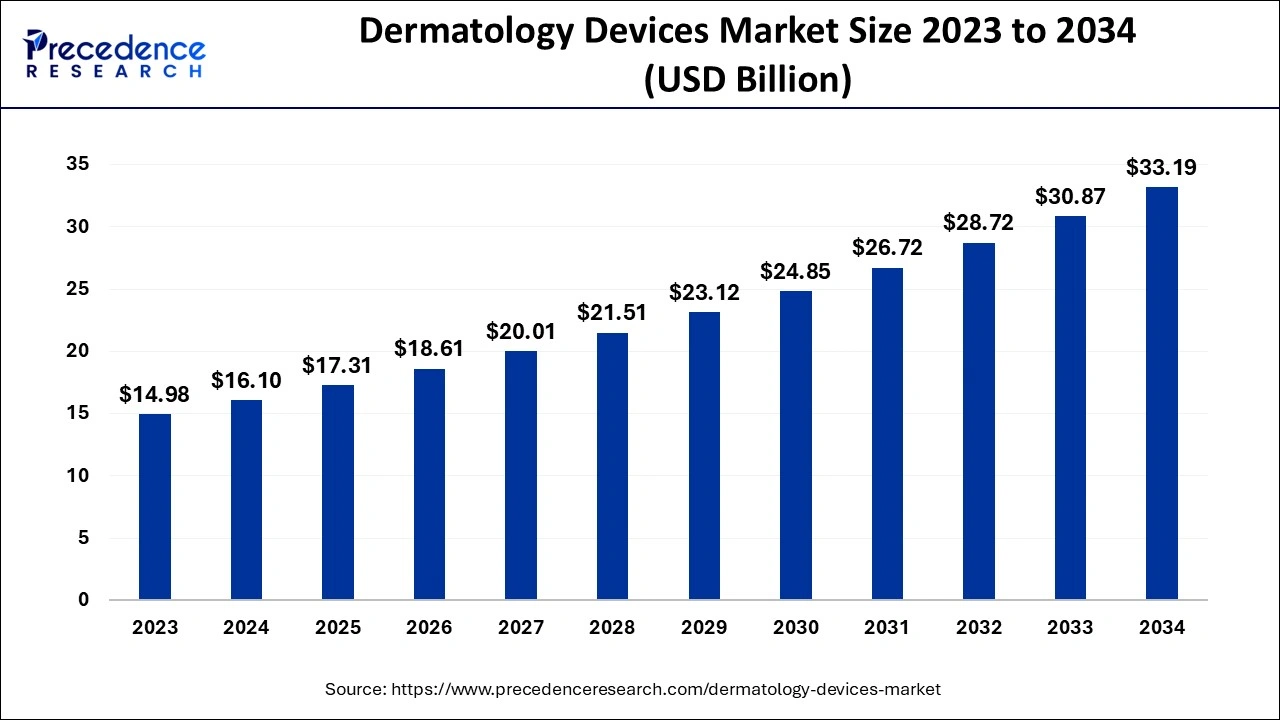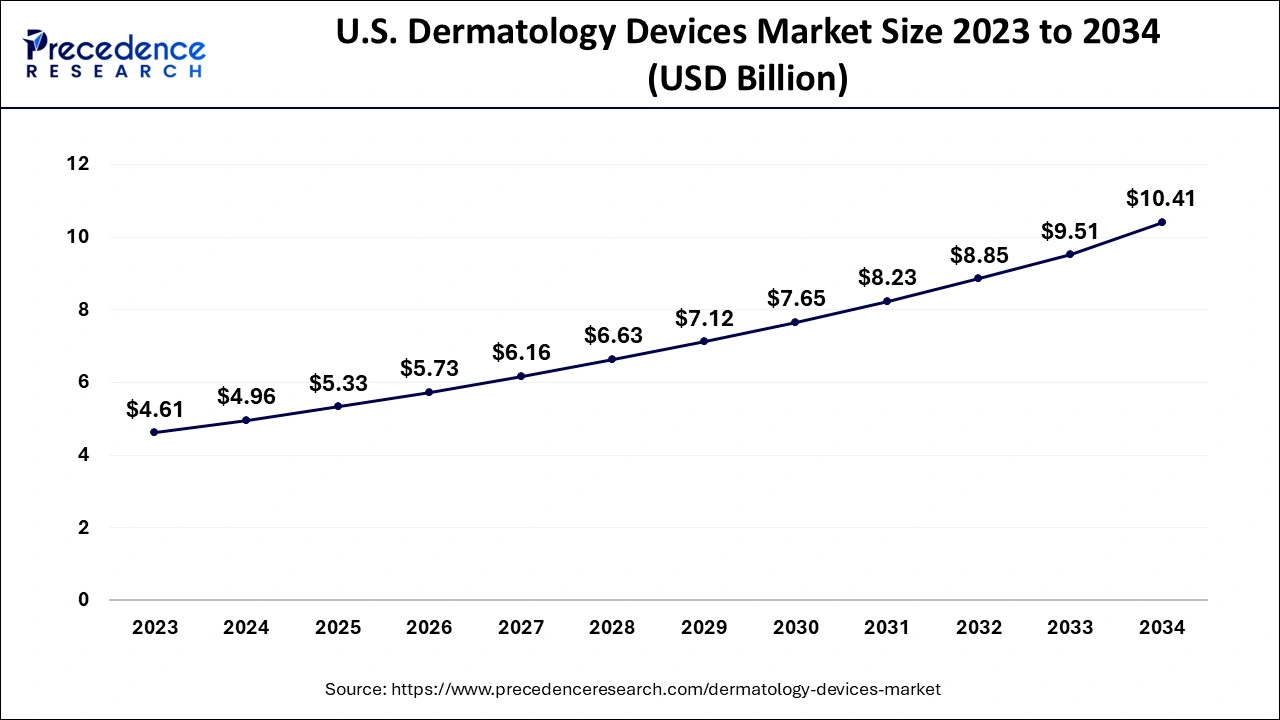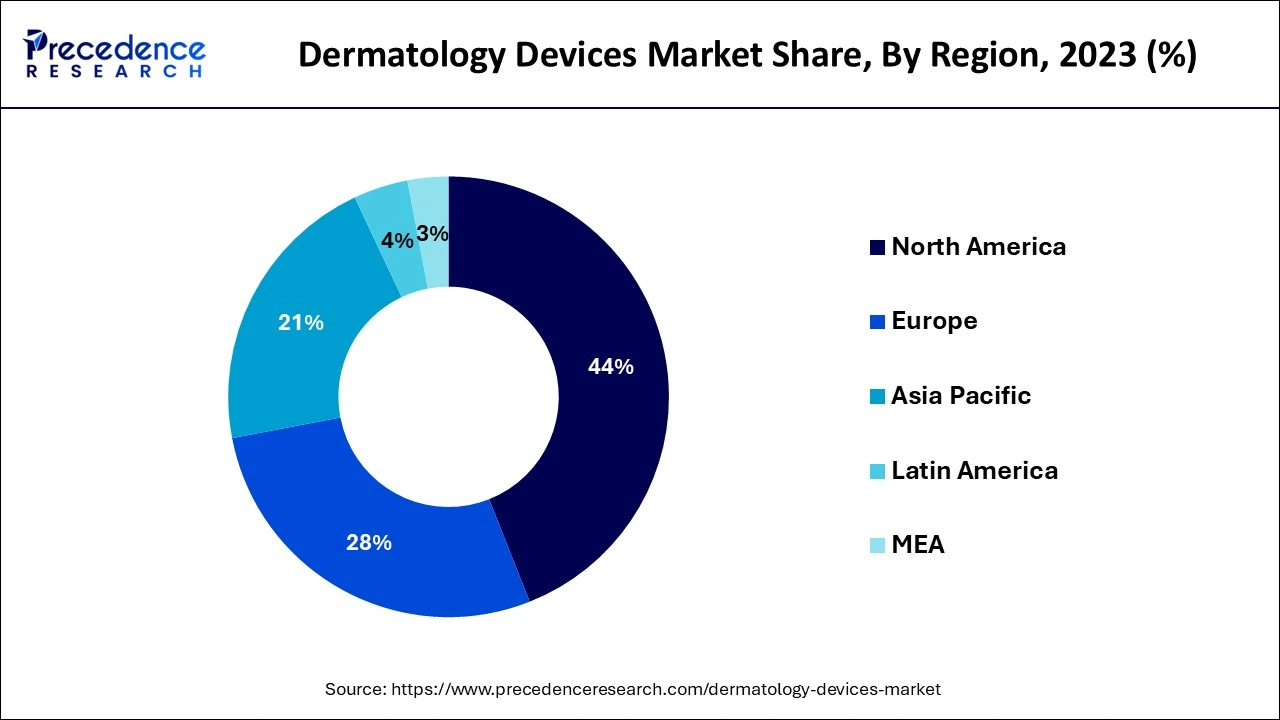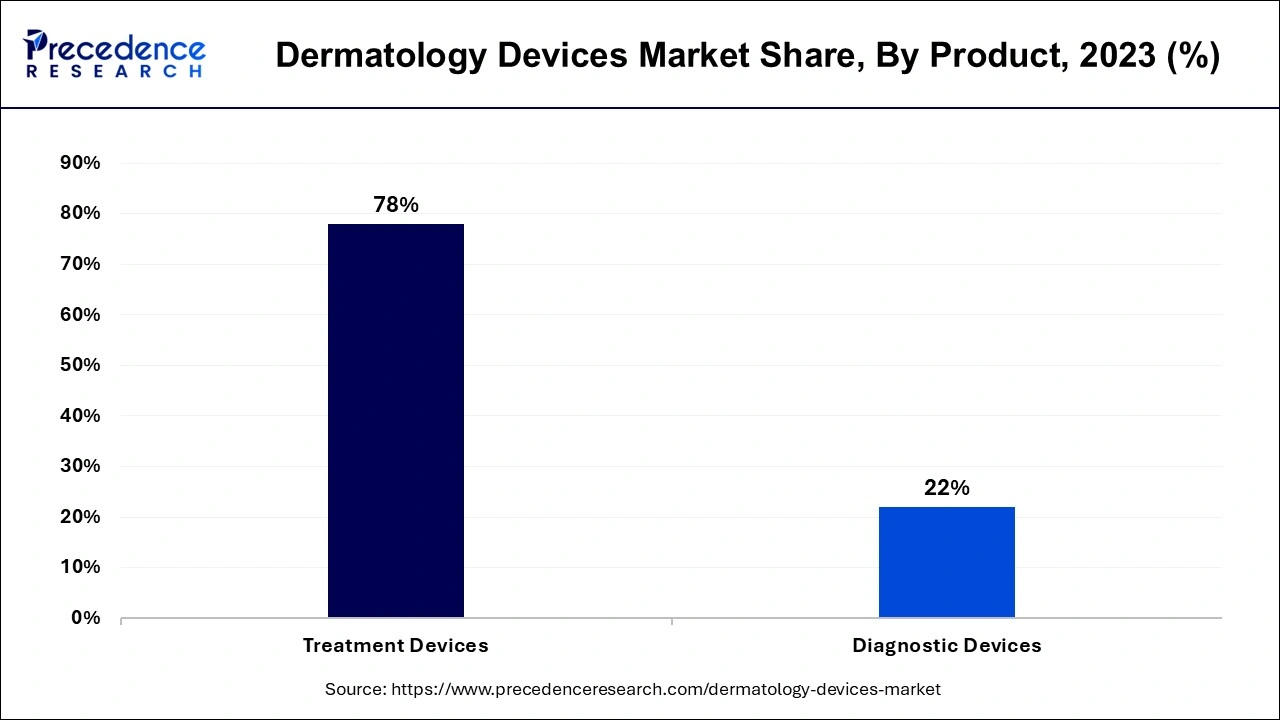November 2024
The global dermatology devices market size accounted for USD 16.10 billion in 2024, grew to USD 17.31 billion in 2025 and is predicted to surpass around USD 33.19 billion by 2034, representing a healthy CAGR of 7.50% between 2024 and 2034. The North America dermatology devices market size is calculated at USD 7.08 billion in 2024 and is expected to grow at a fastest CAGR of 7.61% during the forecast year.
The global dermatology devices market size is estimated at USD 16.10 billion in 2024 and is anticipated to reach around USD 33.19 billion by 2034, expanding at a CAGR of 7.50% from 2024 to 2034.

The U.S. dermatology devices market size is evaluated at USD 4.96 billion in 2024 and is predicted to be worth around USD 10.41 billion by 2034, rising at a CAGR of 7.69% from 2024 to 2034.

The North American region had the largest revenue share till the year 2023. About 44% of the revenue share was held by the North American region. The prevailing skin cancer and skin diseases are increasing. The regional markets are expected to grow as there's an increasing demand for these procedures. About 80% of the US population is affected by acne vulgaris. About 20% of people suffer from severe acne, resulting in a permanent physical scar.
Apart from the North American market, the Asia Pacific market is also expected to register the fastest growth rate in the forecast period. The market shall rapidly grow with increased medical tourism in the Asia Pacific region. The various options of treatments shall be the key factors boosting the regional market growth. An increased number of investments in research and development by various multinational companies in the Asia Pacific region is another important factor that is driving the regional market.

The need for dermatological devices has been increasing throughout Europe, particularly in Russia and other North European nations. Market expansion in the area of dermatological devices is being driven by technological improvements, rising healthcare expenditures, and an aging population. Europe has been a significant location in the dermatological devices market as people become more conscious of cosmetic procedures.
With the growing interest among people in aesthetics, the LAMEA area is expected to have the fastest growth rate over the study period. During the forecast period, light therapy, liposuction, and lasers are expected to have the highest market share in the LAMEA region.
In order to diagnose and cure skin conditions, dermatology devices are used. The equipment is utilized for skin-treating procedures including electrodessication & curettage, cryosurgery, photodynamic treatment, Mohs micrographic surgery, topical chemotherapy, and skin biopsy. Skin cancer is becoming more common as the ozone layer depletes. While skin cancer diagnostics is one of the main application sectors of the market. Cosmetic surgery is becoming increasingly popular across the world due to the craze for looking good. Scars and markings are common side effects of most surgical operations. Traditional surgical approaches are being replaced with dermatology devices to avoid unsightly scars from surgery or therapy. Dermatology systems are installed in hospitals and dermatology clinics to help physicians in the treatment of skin issues.
The increasing prevalence of skin diseases and skin cancers is leading to product demand. About 10,000 people die due to Melanoma every year in the US according to the report by the Skin Cancer Foundation. There is a growing need for the diagnosis of skin disorders. The lockdown and the supply chain disruption due to the pandemic had negatively affected the market due to limited operations of manufacturing the growth of the market had reduced. There was a complete suspension of any other surgeries apart from COVID-19 the market saw negative growth. Many people are increasingly concerned about their aesthetic appeal. They shall help and support the market growth. People are switching to better diagnosis and treatment of various skin diseases rather than using conventional products. This helps in improving the appearance of the skin. The introduction of various technologically advanced invasive laser therapies is also in great demand in this market.
| Report Coverage | Details |
| Growth Rate from 2024 to 2034 | CAGR of 7.50% |
| Market Size in 2024 | USD 16.10 Billion |
| Market Size by 2034 | USD 33.19 Billion |
| Base Year | 2023 |
| Forecast Period | 2024 to 2034 |
| Segments Covered | Products, Application, End User and Geography |
To enhance aesthetic appeal, many people are adopting the use of devices. Technological advancements in dermatology devices also helped in the growth of the market. And increased disposable income is also an important factor that is driving the market growth. The prevailing cases of non-melanoma skin cancer and melanoma are rising across many nations which is also expected to increase the market for dermatology devices. Genetic issues, aging, and environmental factors lead to the development of various skin diseases. The use of advanced technology for removing dark spots is also expected to drive product demand during the forecast period. Microdermabrasion is a procedure that is used to reduce scarring wrinkles and renew the overall skin tone. The increased awareness of the availability of such procedures in the market is driving the demand for dermatology procedures across various nations. Major market players or improving the dermatology devices portfolio by revising their existing product portfolios with the help of innovation.
Growing research and development expenditures, particularly in established and emerging nations, in the field of medical services, will provide more beneficial market growth prospects. The market growth rate is additionally reinforced by research and development capabilities for tissue regeneration methods. The governments of China and India's increased spending is expected to hit the market. Furthermore, the expansion of the healthcare business, which is driven by both public and private agencies, will generate attractive market growth prospects, particularly in developing nations.
Non-specialists cannot make diagnostic conclusions without extra training, as the “German SCREEN” program was recognized a decade ago. Understanding typical skin features and lesion characteristics are required to correctly read dermatological infections. Primary Care Providers (PCPs) deliver better initial diagnoses and send the right patients to dermatology experts by providing specialized training and continuous certification. Additionally, a study in Missouri indicated that after 12 months of participation in a remote dermatological training program, Primary Care Providers (PCP) improved their diagnosis accuracy by a statistically significant amount.
Dermatological devices, which allow the practitioner to observe lesions in more detail, are employed in the vast majority of dermatological offices. Greater magnification, clarity, and consistency of imaging, as well as the capacity to record pictures to follow lesion changes over time, have pushed the implementation of digital dermatological equipment into routine clinical practice. However, with the upfront capital investment required, worries about IT infrastructure, and the probable need for more sophisticated training, PCP (Primary Care Providers) acceptance has been slow-moving which is suppressing the market growth. To address this, technology companies must provide solutions that are user-friendly, financially viable, secure, and compliant with all regulatory standards.
Also, advances in optical technology and artificial intelligence are paving the way for future clinical practice growth. These might be especially valuable in the community environment, where learning algorithms and explainable AI built in collaboration with experts could help with lesion analytics, multi-spectral mapping, and diagnostic confidence intervals, among other things. These intelligent algorithms have the potential to assist PCPs in making skin-care decisions.
Investments in digital infrastructure might be difficult for community-based providers because they lack the IT competence of the acute sector. Cloud-based technologies allow providers to depend on shared cybersecurity services to improve patient data protection. Furthermore, having an integrated IT infrastructure simplifies the referral process by enabling the safe bi-directional transfer of lesion imaging, reporting, and patient data across the referral network.
The treatment devices market segment had the largest market share in the recent years. The availability of wide applications for dermatology treatment is the main reason for the market's growth. The segment is expected to grow due to the launch of novel technologies in the laser device category.

The laser product had the largest market share till the year 2023 and it is expected to have the fastest CAGR during the forecast period due to the adoption and usage of these laser products. The diagnostic devices segment was dominated by dermatoscopy. The availability of advanced technologies has helped in the growth of the segment. There shall be significant growth over the forecast due to skin cancer diagnosis and the prevalence of disease and increasing emphasis on early detection. Maximum revenue share was generated by the laser hair removal devices as there are a huge number of benefits associated with the laser hair removal techniques.
Based on the end-user, the hospital segment had the largest market share of 50% in 2023 and it shall grow during the forecast period due to the adoption of advanced dermatology equipment in the hospitals. These facilities have numerous treatment options that help increase the number of skin disease diagnosis visits and support their segment growth.
The clinics end-user segment is also expected to have good growth during the forecast period till the year 2034. These clinics focus on the diagnosis and treatment of various skin conditions. In dermatology clinics, both non-surgical and surgical services are offered by certified plastic surgeons. The increasing demand for specialized dermatology treatments is taking patients to these dermatology clinics. To seek effective and rapid service the consumers are visiting the specialized dermatology clinics which are driving the segment growth.
Based on application, the hair removal treatment segment is expected to grow well during the forecast period. The hair removal treatment segment is related to skin rejuvenation, acne psoriasis, wrinkle removal, tattoo removal, body contouring, fat removal, etc. Laser devices for hair removal have proved to be safe for all types of skin tones and hair colors. The use of these laser devices makes the process less painful and it propels the market growth. There's an increasing demand for various cosmetic laser treatments for skin resurfacing, skin tightening, and tattoo removal. The use of cosmetic laser treatments for various reasons has significantly increased the adoption of the devices in this segment. The growing numbers indicate that the demand for aesthetic treatments is increasing across the developing as well as the developed nations. There shall be the adoption of technologically advanced and efficient dermatology devices across many nations which will help in the growth of the market.
By Products
By Application
By End User
By Geography
For inquiries regarding discounts, bulk purchases, or customization requests, please contact us at sales@precedenceresearch.com
No cookie-cutter, only authentic analysis – take the 1st step to become a Precedence Research client
November 2024
November 2024
April 2025
January 2025